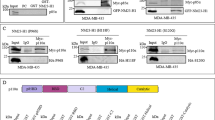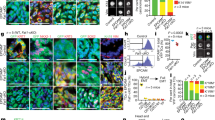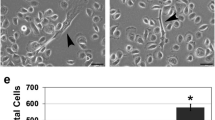Abstract
The human metastasis-associated gene (MTA1), a member of the nucleosome remodeling complex with histone deacetylase activity, is frequently overexpressed in biologically aggressive epithelial neoplasms. Here, we extend this observation to squamous carcinoma cells, which express high levels of MTA1 relative to normal or immortalized keratinocytes. To address functional aspects of MTA1 expression, we established variants of human immortalized keratinocytes (HaCaT cells) by expressing MTA1 cDNA in both the sense and antisense orientations. We demonstrate that (1) forced MTA1 expression enhances migration and invasion of immortalized keratinocytes; (2) MTA1 expression is necessary but not sufficient for cell survival in the anchorage independent state; (3) MTA1 contributes to expression of the anti-apoptotic Bcl-2 family member Bcl-xL; (4) MTA1 expression in immortalized keratinocytes depends, in part, on activation of the epidermal growth factor receptor (EGFR). These results establish that, in keratinocytes, MTA1 expression contributes to several aspects of the metastatic phenotype including survival in the anchorage independent state, migration, and invasion.
This is a preview of subscription content, access via your institution
Access options
Subscribe to this journal
Receive 50 print issues and online access
$259.00 per year
only $5.18 per issue
Buy this article
- Purchase on Springer Link
- Instant access to full article PDF
Prices may be subject to local taxes which are calculated during checkout







Similar content being viewed by others
Abbreviations
- EGFR:
-
epidermal growth factor receptor
- MTA1:
-
metastasis-associated protein 1
References
Ahmed NU, Ueda M, Ichihashi M . 1997 Br. J. Derm. 136: 908–912
Barnard JA, Graves-Deal R, Pittelkow MR, Du Bois R, Cook P, Ramsey GW, Bishop PR, Damstrup L, Coffey RJ . 1994 J. Biol. Chem. 269: 22817–22822
Basu A, Murthy U, Rodeck U, Herlyn M, Mattes L, Das M . 1987 Cancer Res. 47: 2531–2536
Boukamp P, Petrussevska RT, Breitkreutz D, Hornung J, Markham A, Fusenig NE . 1988 J. Cell Biol. 106: 761–771
Frisch SM, Francis H . 1994 J. Cell Biol. 124: 619–626
Futamura M, Nishimori H, Shiratsuchi T, Saji S, Nakamura Y, Tokino T . 1999 J. Hum. Genet. 44: 52–66
Gossen M, Bujard H . 1992 Proc. Natl. Acad. Sci. USA 89: 5547–5551
Herman MA, Ch'ng Q, Hettenbach SM, Ratliff TM, Kenyon C, Herman RK . 1999 Development 126: 1055–1064
Jost M, Class R, Kari C, Jensen PJ, Rodeck U . 1999 J. Invest. Dermatol. 112: 443–449
Jost M, Huggett TM, Kari C, Rodeck U . 2001a Mol. Biol. Cell 12: 1519–1527
Jost M, Huggett TM, Kari C, Boise LH, Rodeck U . 2001b J. Biol. Chem. 276: 6320–6326
Jost M, Kari C, Rodeck U . 1997 Nucleic Acids Res. 25: 3131–3134
Kawahara E, Imai K, Kumagai S, Yamamoto E, Nakanishi I . 1995 J. Cancer Res. Clin. Oncol. 121: 133–140
Kleene R, Zdzieblo J, Wege K, Kern H . 1999 J. Cell Sci. 112: 2539–2548
Le Jeune S, Leek R, Horak E, Plowman G, Greenall M, Harris AL . 1993 Cancer Res. 53: 3597–3602
Levitzki A, Gazit A . 1995 Science 267: 1782–1788
Mahoney MG, Aho S, Uitto J, Stanley JR . 1998 J. Invest. Dermatol. 111: 308–313
Mansour SJ, Matten WT, Hermann AS, Candia JM, Rong S, Fukasawa K, Vande Woude GF, Ahn NG . 1994 Science 265: 966–970
Mazumdar A, Wang RA, Mishra SK, Adam L, Bagheri-Yarmand R, Mandal M, Vadlamudi RK, Kumar R . 2001 Nature Cell Biol. 3: 30–37
McNeill H, Jensen PJ . 1990 Cell Regul. 1: 843–852
Mukaida H, Toi M, Hirai T, Yamashita Y, Toge T . 1991 Cancer 68: 142–148
Murthy U, Basu A, Rodeck U, Herlyn M, Ross AH, Das M . 1987 Arch. Biochem. Biophys. 252: 549–560
Murthy U, Rieman DJ, Rodeck U . 1990 Biochem. Biophys. Res. Commun. 172: 471–476
Nawa A, Nishimori K, Lin P, Maki Y, Moue K, Sawada H, Toh Y, Fumitaka K, Nicolson GL . 2000 J. Cell Biochem. 79: 202–212
Ozawa S, Ueda M, Ando N, Shimizu N, Ab O . 1989 Cancer 63: 2169–2173
Paterno GD, Li Y, Luchman HA, Ryan PJ, Gillespie LL . 1997 J. Biol. Chem. 272: 25592–25595
Pinkas-Kramarski R, Lenferink AE, Bacus SS, Lyass L, van de Poll ML, Klapper LN, Tzahar E, Sela M, van Zoelen EJ, Yarden Y . 1998 Oncogene 16: 1249–1258
Rodeck U, Herlyn M, Herlyn D, Motlhoff C, Atkinson B, Varello M, Steplewski Z, Koprowski H . 1987 Cancer Res. 47: 3692–3696
Rodeck U, Jost M, DuHadaway J, Kari C, Jensen P, Risse B, Ewert D . 1997 Proc. Natl. Acad. Sci. USA 94: 5067–5072
Rodeck U, Melber K, Kath R, Menssen HD, Varello M, Atkinson B, Herlyn M . 1991 J. Invest. Dermatol. 97: 20–26
Rosen K, Rak J, Leung R, Dean NM, Kerbel RS, Filmus J . 2000 J. Cell Biol. 149: 447–455
Simpson S, Uitto J, Rodeck U, Mahoney MG . 2001 Gene 273: 29–39
Toh Y, Kuninaka S, Endo K, Oshiro T, Ikeda Y, Nakashima H, Baba H, Kohnoe S, Okamura T, Nicolson GL, Sugimachi K . 2000 J. Exp. Clin. Cancer Res. 19: 105–111
Toh Y, Kuwano H, Mori M, Nicolson GL, Sugimachi K . 1999 Br. J. Cancer 79: 1723–1726
Toh Y, Pencil SD, Nicolson GL . 1995 Gene 159: 97–104
Toh Y, Pencil SD, Nicolson GL . 1994 J. Biol. Chem. 37: 22958–22963
Yoneda T, Lyall RM, Alsina MM, Persons PE, Spada AP, Levitzki A, Zilberstein A, Mundy GR . 1991 Cancer Res. 51: 4430–4435
Zhang Y, Ng HH, Erdjument-Bromage H, Tempst P, Bird A, Reinberg D . 1999 Genes Dev. 13: 1924–1935
Zhu Z, Sanchez-Sweatman O, Huang X, Wiltrout R, Khokha R, Zhao Q, Gorelik E . 2001 Cancer Res. 61: 1707–1716
Acknowledgements
We thank Dr PJ Jensen (University of Pennsylvania, Philadelphia, PA, USA) for primary keratinocytes, Dr N Fusenig for HaCaT keratinocytes, and Dr J Rheinwald for squamous carcinoma cells. This work was supported by grants from the National Institutes of Health and the Dermatology Foundation to U Rodeck and MG Mahoney, respectively. MG Mahoney is a recipient of a Career Development Award from the Dermatology Foundation.
Author information
Authors and Affiliations
Corresponding author
Rights and permissions
About this article
Cite this article
Mahoney, M., Simpson, A., Jost, M. et al. Metastasis-associated protein (MTA)1 enhances migration, invasion, and anchorage-independent survival of immortalized human keratinocytes. Oncogene 21, 2161–2170 (2002). https://doi.org/10.1038/sj.onc.1205277
Received:
Revised:
Accepted:
Published:
Issue Date:
DOI: https://doi.org/10.1038/sj.onc.1205277
Keywords
This article is cited by
-
Metastasis-associated protein 1: A potential driver and regulator of the hallmarks of cancer
Journal of Biosciences (2022)
-
MTA1 promotes metastasis of MPM via suppression of E-cadherin
Journal of Experimental & Clinical Cancer Research (2015)
-
Significance of MTA1 in the molecular characterization of osteosarcoma
Cancer and Metastasis Reviews (2014)
-
Overexpression of MTA1 promotes invasiveness and metastasis of ovarian cancer cells
Irish Journal of Medical Science (1971 -) (2014)
-
Metastatic tumor antigen in hepatocellular carcinoma: golden roads toward personalized medicine
Cancer and Metastasis Reviews (2014)



